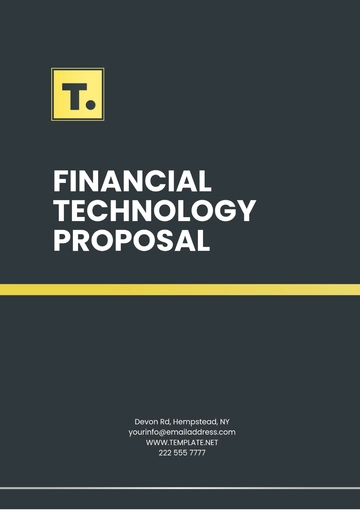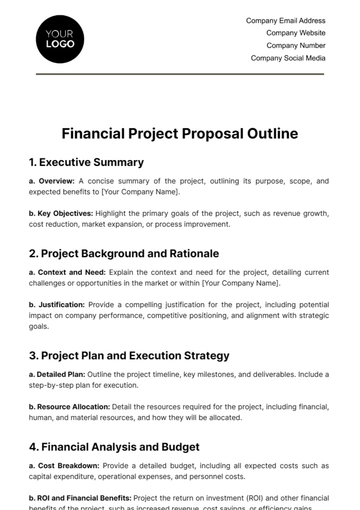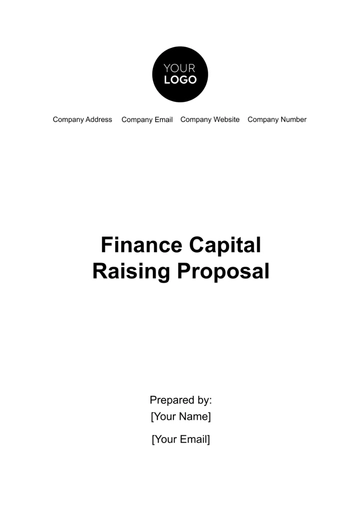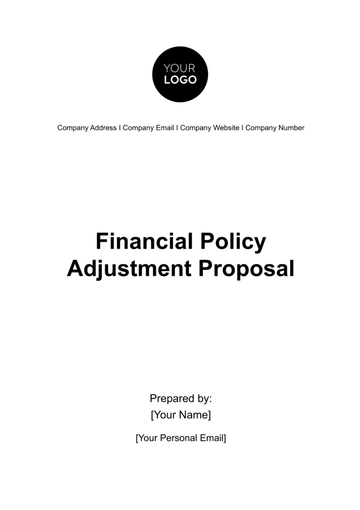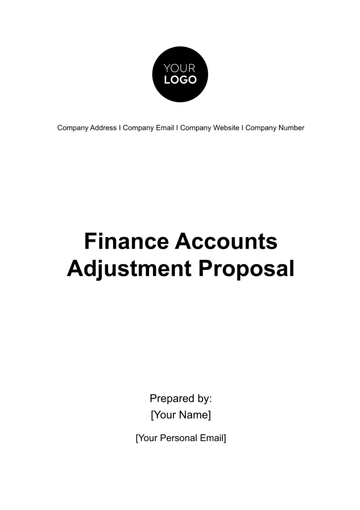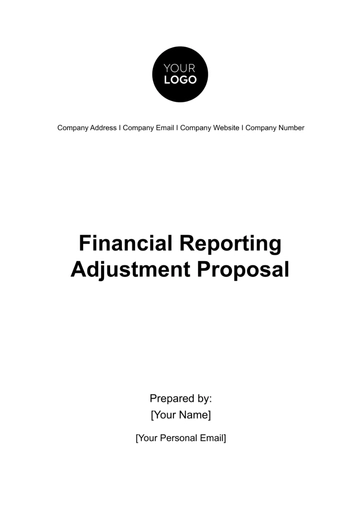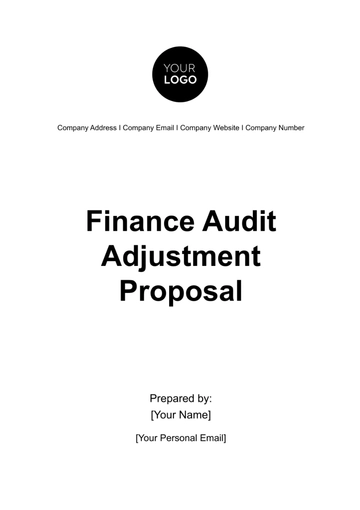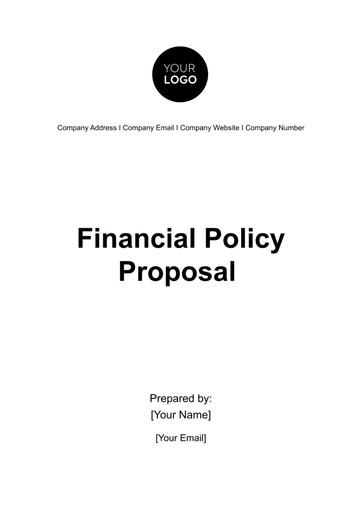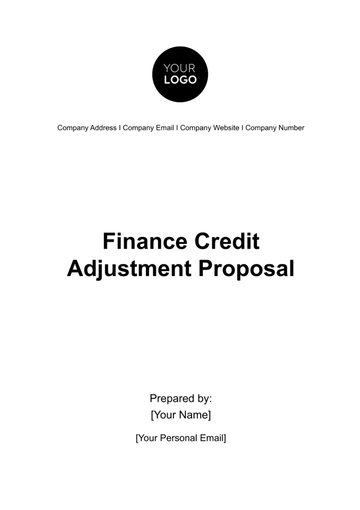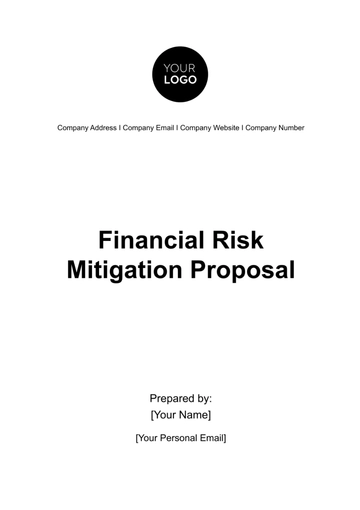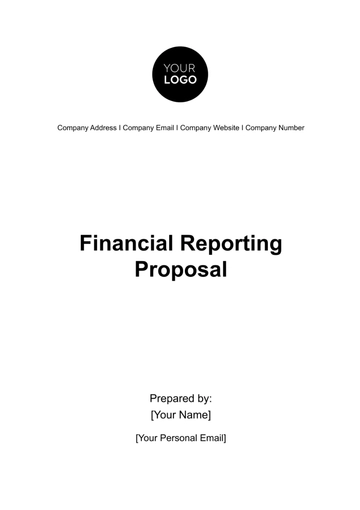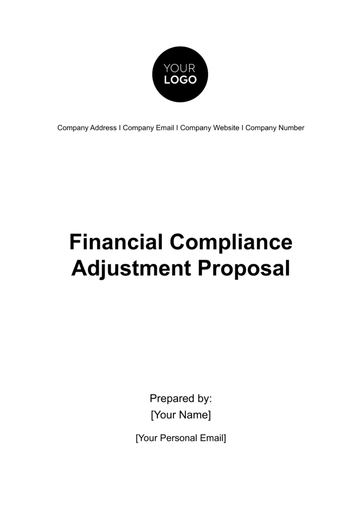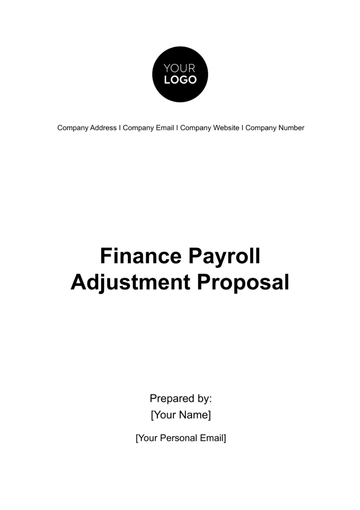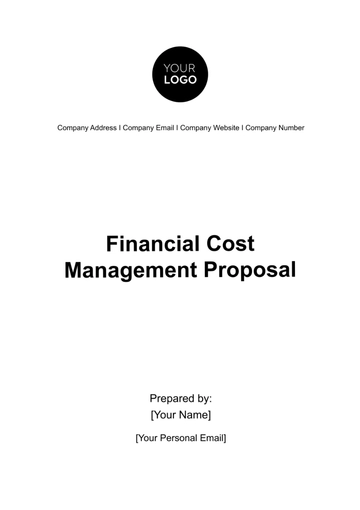Free Financial Policy Proposal
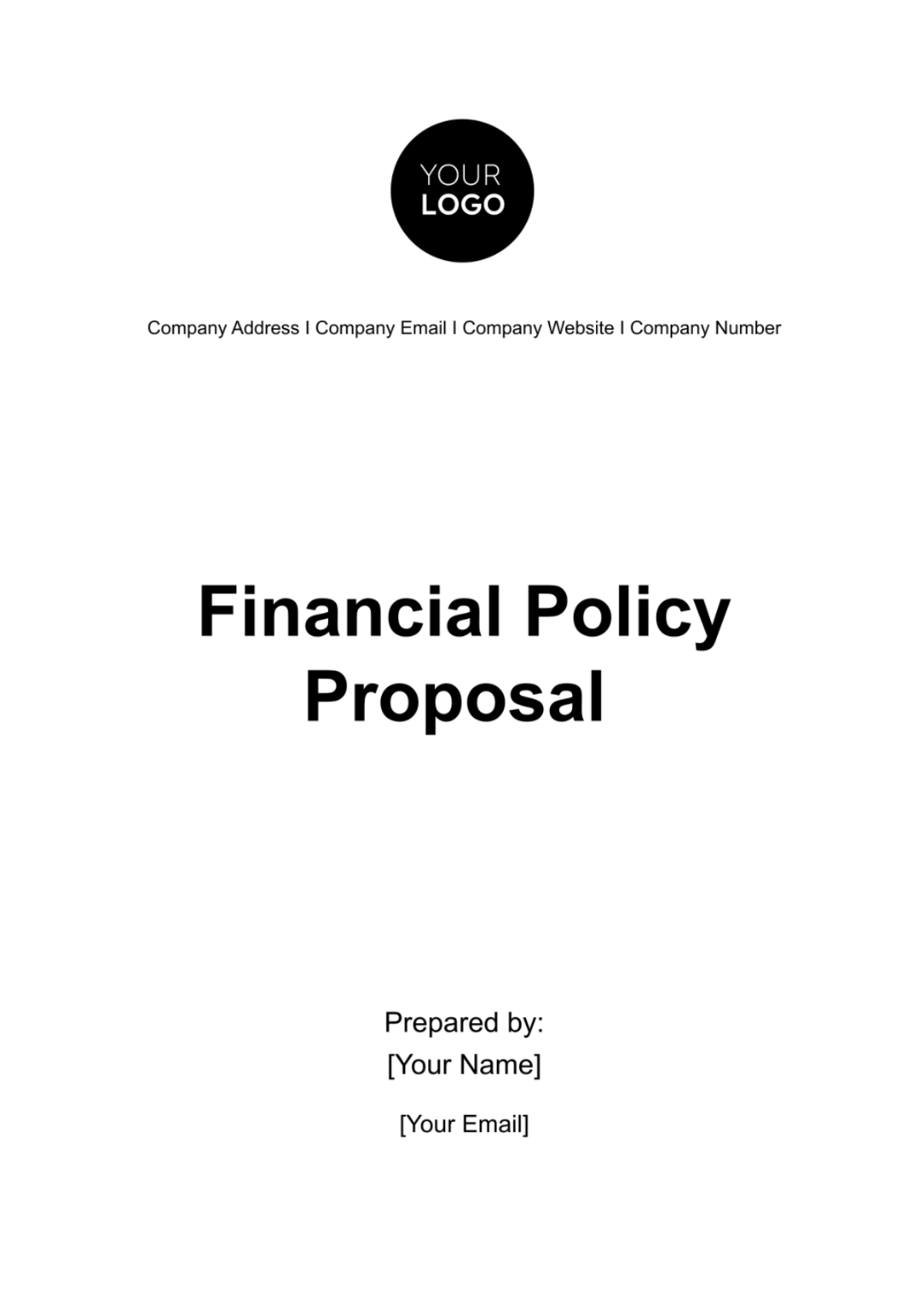
I. Executive Summary
Overview
This proposal outlines the new financial policy designed to enhance financial stability, compliance, and efficiency in [Your Company Name]. It targets key areas such as budget management, risk assessment, and investment strategies.
Objectives
Improve financial planning and reporting accuracy.
Ensure compliance with regulatory standards.
Optimize investment and resource allocation.
Outcomes
We expect to achieve a more streamlined financial operation, reducing operational costs by 15% and improving financial reporting accuracy by 20%.
II. Introduction
In the ever-evolving financial landscape, [Your Company Name] faces challenges such as fluctuating market conditions, evolving regulatory requirements, and the need for efficient resource allocation.
This policy is critical to maintaining our competitive edge, ensuring financial stability, and meeting stakeholder expectations.
III. Problem Statement
The Challenge
In the last fiscal year, [Your Company Name] experienced a concerning 10% budget overrun. This deviation from our projected financial plan has raised significant internal concerns regarding our budgeting and forecasting accuracy. This issue is compounded by a 5% shortfall in compliance with new financial regulations, particularly in areas related to environmental standards and data protection. These compliance challenges have emerged due to the rapidly evolving regulatory landscape and our existing financial policies not being agile enough to adapt to these changes.
Impact
The budget overrun has led to an unplanned depletion of our financial reserves, which could jeopardize our ability to invest in new projects and innovations. Additionally, the compliance shortfall has raised red flags with regulatory bodies, risking fines and sanctions. Perhaps most importantly, these issues have led to a tangible decrease in stakeholder confidence, as evidenced by feedback from our last shareholder meeting and dips in employee morale. These challenges, if not addressed, pose significant long-term financial risks to the company, including potential loss of market share and damage to our brand reputation.
IV. Policy Objectives
Short-Term Objective
Our immediate goal is to achieve full compliance with all financial regulations within the next fiscal quarter. This involves a thorough audit of our current practices, identification of compliance gaps, and swift implementation of corrective measures. This objective is critical to restoring regulatory and stakeholder confidence and avoiding any potential legal and financial penalties.
Long-Term Objective
Over the next five years, we aim to increase overall financial stability and enhance stakeholder value. This involves restructuring our financial management processes to ensure greater accuracy in budgeting and forecasting, improving our agility in response to changing regulations, and fostering a culture of financial responsibility at all levels of the company. This long-term objective is aligned with our strategic goal of sustainable growth and market leadership.
V. Policy Options and Analysis
Option 1: Status Quo
Pros: Continuation of current practices avoids the immediate costs and disruptions associated with implementing new policies. Employees and management are familiar with existing processes, which minimizes training requirements.
Cons: Persisting with the current approach is likely to result in ongoing issues with budget management and regulatory compliance. This could lead to increased financial risks, potential legal issues, and continued erosion of stakeholder confidence.
Option 2: Comprehensive Financial Policy Overhaul
Pros: This option addresses our current challenges head-on by implementing a robust, modern financial management framework. It promises improved budget accuracy, full regulatory compliance, and a foundation for sustainable financial practices. In the long term, this option positions the company for greater financial stability and enhanced shareholder value.
Cons: The overhaul will require significant upfront investment in terms of resources, time, and training. The initial phase of this transition may also see resistance from staff due to changes in established procedures and the need for adaptation.
Recommendation: |
|---|
It is recommended to proceed with Option 2. Despite the initial challenges, this option offers substantial long-term benefits and aligns with our strategic goals of sustainability and growth. |
VI. Implementation Strategy
Steps:
Policy Communication: A comprehensive communication plan to inform all employees about the new financial policy, its importance, and its impact on various departments.
Training and Development: A series of training programs and workshops to equip employees with the necessary skills and knowledge to adapt to the new financial processes.
Phased Rollout: Implementing the policy in phases, starting with the most critical areas such as compliance and budgeting, followed by a gradual rollout to other departments.
Timeline:
Q1: | ➨ Initiation, planning, and development of training materials. |
Q2-3: | ➨ Implementation in key departments, ongoing training, and feedback collection. |
Q4: | ➨ Review of implementation success, identification of areas for improvement, and planning for next phases. |
Budget
The budget for the entire implementation phase is projected to be approximately $500,000. This includes costs for training, additional personnel for project management, and resources for communication and monitoring.
VII. Risk Assessment and Mitigation
Risk: Implementation Delays
Mitigation: Implement a detailed project management plan with clear milestones and deadlines. Regular progress reviews and flexibility in the plan to accommodate unforeseen delays.
Risk: Staff Resistance
Mitigation: A comprehensive change management strategy, including open forums for employee feedback, addressing concerns transparently, and highlighting the personal and organizational benefits of the new policy.
VIII. Impact Analysis
Economic Impact
The new policy is projected to lead to a 10% increase in operational efficiency. This improvement is expected due to more accurate budgeting, reduced regulatory risk, and more efficient resource allocation. The reduction in financial wastage and penalties will also contribute to a healthier bottom line.
Social Impact
Improved employee morale is anticipated through clearer financial processes and a more stable work environment. Enhanced compliance will also improve our corporate image, reinforcing our commitment to ethical and responsible business practices.
IX. Consultation and Stakeholder Engagement
Process
Employee Focus Groups: Organizing sessions with employees from various departments to gather input on current financial processes and potential improvements.
Stakeholder Surveys: Conduct surveys among key stakeholders, including investors, regulators, and major clients, to understand their expectations and concerns regarding our financial practices.
Feedback Incorporation
The training programs will be adjusted based on employee feedback, ensuring they are relevant and effective. Feedback from stakeholders will be used to fine-tune policy elements to better align with external expectations.
X. Legal and Regulatory Considerations
Identification of Relevant Laws and Regulations
This involves listing all the laws and regulations that impact the financial operations of the company. This could include tax laws, securities and exchange regulations, anti-money laundering (AML) laws, data protection regulations, and environmental laws. The purpose is to have a clear understanding of the legal landscape in which the company operates.
Compliance Strategy
Develop a strategy to ensure that all aspects of the financial policy are in compliance with these laws and regulations. This could involve setting up new processes, revising existing ones, or implementing specific compliance checks at various stages of the financial workflow.
Establishment of a Compliance Task Force
This involves creating a dedicated team responsible for monitoring compliance with these laws and regulations. This task force would be responsible for staying abreast of any changes in the legal landscape, assessing their impact on the company's financial policies, and recommending modifications to maintain compliance.
Training and Awareness
Ensuring that all employees, especially those in finance and management roles, are aware of the relevant laws and regulations, and understand how these impact their work. Regular training sessions might be necessary to keep the staff updated on legal changes and compliant practices.
Regular Audits and Reviews
Conduct regular audits to check for compliance and review the financial policies periodically to ensure ongoing adherence to legal and regulatory requirements.
Documentation and Reporting
Keeping thorough records of compliance efforts, audits, and any issues encountered. This documentation is crucial not only for internal tracking but also for demonstrating compliance efforts to regulatory bodies or in legal contexts.
XI. Monitoring and Evaluation
Monitoring Framework
Establishing a framework for regular monitoring of the financial policy's implementation. This involves setting up key performance indicators (KPIs) and metrics that reflect the policy's objectives, such as budget adherence, cost savings, compliance rates, and efficiency improvements.
Financial Performance Reviews
Conduct monthly reviews of the company's financial performance. These reviews would assess how well the company's financial activities align with the policy, identify areas where the policy might not be effectively implemented, and highlight any unexpected outcomes or issues.
Stakeholder Feedback
Gathering feedback from various stakeholders, including employees, management, shareholders, and regulatory bodies. This feedback provides insights into how the policy is perceived and its impact on different groups.
Annual Policy Effectiveness Assessment
Annually assessing the effectiveness of the policy in meeting its objectives. This would involve a comprehensive analysis that looks at both quantitative data (like financial metrics) and qualitative input (like stakeholder feedback).
Adjustment and Continuous Improvement
Based on the monitoring and evaluation findings, making necessary adjustments to the financial policy. This ensures that the policy remains effective and relevant, adapting to changes in the company's internal and external environment.
Documentation and Reporting
Keeping detailed records of all monitoring and evaluation activities. Regular reports should be prepared to inform management and stakeholders about the policy's performance and any recommended changes.
XII. Conclusion and Recommendations
This Financial Policy Proposal is a critical step towards enhancing the financial health and stakeholder value of [Your Company Name]. It addresses key challenges in our financial operations, lays the foundation for sustainable financial practices, and aligns with our strategic objectives. The successful implementation of this policy will not only stabilize our financial situation but also contribute to our reputation as a responsible and forward-thinking organization. We recommend a firm commitment to this policy and an organized effort towards its effective implementation.
- 100% Customizable, free editor
- Access 1 Million+ Templates, photo’s & graphics
- Download or share as a template
- Click and replace photos, graphics, text, backgrounds
- Resize, crop, AI write & more
- Access advanced editor
Propose and develop robust financial policies with Template.net's Financial Policy Proposal Template. Tailored for clarity and impact, this professional template is both editable and customizable, allowing for precise policy formulation. It provides a structured approach to proposing new or revised financial policies, ensuring thorough consideration and seamless integration into your financial governance framework. Edit this template using our Ai Editor Tool only at Template.net.
You may also like
- Business Proposal
- Research Proposal
- Proposal Request
- Project Proposal
- Grant Proposal
- Photography Proposal
- Job Proposal
- Budget Proposal
- Marketing Proposal
- Branding Proposal
- Advertising Proposal
- Sales Proposal
- Startup Proposal
- Event Proposal
- Creative Proposal
- Restaurant Proposal
- Blank Proposal
- One Page Proposal
- Proposal Report
- IT Proposal
- Non Profit Proposal
- Training Proposal
- Construction Proposal
- School Proposal
- Cleaning Proposal
- Contract Proposal
- HR Proposal
- Travel Agency Proposal
- Small Business Proposal
- Investment Proposal
- Bid Proposal
- Retail Business Proposal
- Sponsorship Proposal
- Academic Proposal
- Partnership Proposal
- Work Proposal
- Agency Proposal
- University Proposal
- Accounting Proposal
- Real Estate Proposal
- Hotel Proposal
- Product Proposal
- Advertising Agency Proposal
- Development Proposal
- Loan Proposal
- Website Proposal
- Nursing Home Proposal
- Financial Proposal
- Salon Proposal
- Freelancer Proposal
- Funding Proposal
- Work from Home Proposal
- Company Proposal
- Consulting Proposal
- Educational Proposal
- Construction Bid Proposal
- Interior Design Proposal
- New Product Proposal
- Sports Proposal
- Corporate Proposal
- Food Proposal
- Property Proposal
- Maintenance Proposal
- Purchase Proposal
- Rental Proposal
- Recruitment Proposal
- Social Media Proposal
- Travel Proposal
- Trip Proposal
- Software Proposal
- Conference Proposal
- Graphic Design Proposal
- Law Firm Proposal
- Medical Proposal
- Music Proposal
- Pricing Proposal
- SEO Proposal
- Strategy Proposal
- Technical Proposal
- Coaching Proposal
- Ecommerce Proposal
- Fundraising Proposal
- Landscaping Proposal
- Charity Proposal
- Contractor Proposal
- Exhibition Proposal
- Art Proposal
- Mobile Proposal
- Equipment Proposal
- Student Proposal
- Engineering Proposal
- Business Proposal




